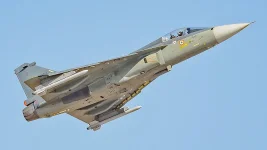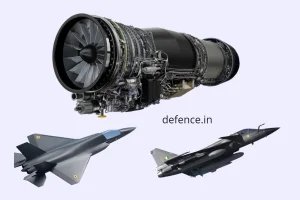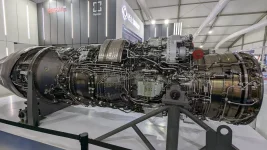- Views: 3K
- Replies: 10
India is taking a significant leap in aerospace technology with its ambitious Advanced Medium Combat Aircraft (AMCA) program. This initiative aims to develop a state-of-the-art, twin-engine, fifth-generation stealth multirole fighter jet.
Designed by the Aeronautical Development Agency (ADA) under the Defence Research and Development Organisation (DRDO), the AMCA is set to substantially strengthen the combat capabilities of the Indian Air Force (IAF) and the Indian Navy.
The development of the AMCA is planned in two distinct phases. The initial version, AMCA Mk1, will incorporate current-generation technologies and will be fitted with imported engines.
The subsequent, more advanced AMCA Mk2, is envisioned to feature indigenous sixth-generation technologies, including a powerful new engine developed domestically.
This dual-phase approach underscores India's determination to achieve self-reliance in critical defence manufacturing sectors.
Addressing Strategic Needs and Modernising the Fleet
The AMCA Mk1 is a vital element in India's strategy to upgrade its aging fighter aircraft fleet, which presently includes 4.5-generation aircraft such as the Dassault Rafale and Sukhoi Su-30MKI.The IAF currently operates with approximately 30 fighter squadrons, short of the sanctioned strength of 42.5 squadrons. This gap presents operational challenges, especially considering regional security dynamics, including the deployment of advanced stealth fighters like China's J-20 near Indian borders.
The induction of the AMCA Mk1, expected to commence with two squadrons (36 aircraft), will significantly enhance India's air superiority and its capacity to deter potential adversaries.
For the Mk1, India will initially utilize imported GE F414 engines. This pragmatic decision allows the nation to field a fifth-generation fighter jet relatively quickly while addressing the considerable technological and financial investments required for developing an indigenous powerplant.
The GE F414 engine has a proven track record of reliability in aircraft such as the Boeing F/A-18 Super Hornet, ensuring the AMCA Mk1 will meet required performance standards.
In parallel, the DRDO’s Gas Turbine Research Establishment (GTRE) is focused on the long-term development of an Indian engine.
AMCA Mk2: A Leap Towards Sixth-Generation Capabilities
The AMCA Mk2, anticipated to be ready by 2040, signifies India's ambition to advance beyond current fifth-generation fighter technologies and integrate cutting-edge sixth-generation features.This variant is planned as a fully indigenous platform, powered by a domestically developed 110 kN thrust-class engine, aligning with India's "Atmanirbhar Bharat" (self-reliant India) vision.
The Mk2 is being designed to remain competitive against emerging global aerial threats, including platforms like China’s J-XX and the U.S. Next Generation Air Dominance (NGAD) program.
Key technological advancements planned for the AMCA Mk2 include:
- Indigenous High-Thrust Engine: A primary goal for the Mk2 is its indigenous 110kN engine. Additionally, there are plans for a more powerful sixth-generation engine, potentially generating around 120 kN thrust, to be co-developed by GTRE with an international partner. Discussions are underway with global firms like Rolls-Royce, Safran, and General Electric. This advanced engine is expected to feature adaptive cycle technology, offering significant improvements in range, acceleration, and thermal management, crucial for powering systems like directed-energy weapons. The DRDO is emphasizing complete ownership of Intellectual Property Rights (IPR) and full technology transfer in any foreign collaboration to secure long-term technological independence.
- Advanced Sixth-Generation Technologies: The Mk2 is slated to incorporate Artificial Intelligence (AI)-driven combat systems, offering optionally manned capabilities. This means the aircraft could fly with or without a pilot. It will also be designed to act as a "mothership," controlling unmanned combat aerial vehicles (UCAVs) and swarms of drones. These features will allow a single pilot to manage complex battlefield scenarios with greater precision and situational awareness. Directed-energy weapons, such as lasers and high-power microwaves, are also part of the plan, positioning the Mk2 as a 5.5 to sixth-generation platform.
- Enhanced Stealth and Performance: Building upon the stealth characteristics of the Mk1, the Mk2 will feature advanced materials, improved sensor fusion for better information integration, and a diverterless supersonic inlet to optimize airflow and further reduce its radar signature. Its powerful engines will ensure a superior thrust-to-weight ratio and the ability to sustain supersonic speeds without afterburners (supercruise).
- Export Potential: With full IPR ownership, the AMCA Mk2 could position India as an exporter of advanced fighter jets to friendly nations, thereby enhancing its geopolitical standing and generating economic benefits.
The DRDO estimates an investment of $4.5–5 billion for the engine program alone, with an ambitious timeline of 7–9 years for development.
Lessons learned from the earlier Kaveri engine program highlight the importance of potential foreign collaboration to mitigate risks and accelerate progress.
A final partner for engine co-development is anticipated to be selected by mid-2025, with prototype engines targeted for ground testing by 2032–33.
A Cornerstone of India's Defence Future
The AMCA program is a cornerstone of India’s efforts towards defence modernization and achieving self-reliance. The Mk1 variant will address the IAF's immediate operational requirements, helping to counter regional threats.Its successful induction by 2035 will place India among a select group of nations possessing indigenous fifth-generation fighter aircraft, alongside countries like the U.S., China, and Russia.
The AMCA Mk2, with its indigenous engine and sophisticated sixth-generation features, aims to position India as a significant player in the global aerospace race. This ambitious project, with its strong emphasis on IPR ownership and local production, is expected to foster a robust high-technology aerospace ecosystem within India, creating skilled jobs and potentially paving the way for defence exports.
To ensure streamlined production and minimize delays, the program will involve significant participation from India's private sector, including companies like Larsen & Toubro, Godrej Aerospace, and Kalyani.
The establishment of a special purpose vehicle (SPV) involving Hindustan Aeronautics Limited (HAL), ADA, and private partners further underscores India’s commitment to a collaborative and efficient model for developing this advanced combat aircraft.





